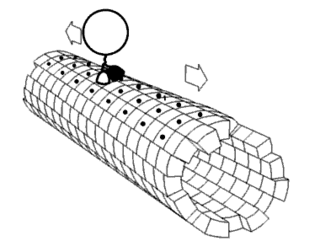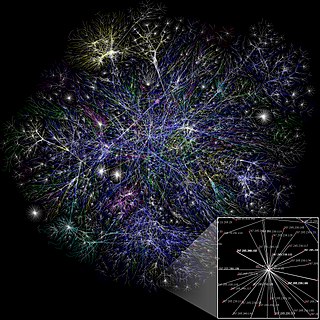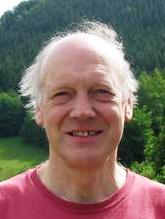Related Research Articles

Biophysics is an interdisciplinary science that applies approaches and methods traditionally used in physics to study biological phenomena. Biophysics covers all scales of biological organization, from molecular to organismic and populations. Biophysical research shares significant overlap with biochemistry, molecular biology, physical chemistry, physiology, nanotechnology, bioengineering, computational biology, biomechanics, developmental biology and systems biology.

In statistical physics and mathematics, percolation theory describes the behavior of a network when nodes or links are added. This is a geometric type of phase transition, since at a critical fraction of addition the network of small, disconnected clusters merge into significantly larger connected, so-called spanning clusters. The applications of percolation theory to materials science and in many other disciplines are discussed here and in the articles Network theory and Percolation.

Edmund Georg Hermann Landau was a German mathematician who worked in the fields of number theory and complex analysis.
Robert Rosen was an American theoretical biologist and Professor of Biophysics at Dalhousie University.
In graph theory, an undirected graph H is called a minor of the graph G if H can be formed from G by deleting edges, vertices and by contracting edges.

Hassler Whitney was an American mathematician. He was one of the founders of singularity theory, and did foundational work in manifolds, embeddings, immersions, characteristic classes, and geometric integration theory.

Norman Woodason Johnson was a mathematician at Wheaton College, Norton, Massachusetts.

A tournament is a directed graph (digraph) obtained by assigning a direction for each edge in an undirected complete graph. That is, it is an orientation of a complete graph, or equivalently a directed graph in which every pair of distinct vertices is connected by a directed edge with any one of the two possible orientations.
Raymond Edward Alan Christopher Paley was an English mathematician who made significant contributions to mathematical analysis before dying young in a skiing accident.
Hysteresivity derives from “hysteresis”, meaning “lag”. It is the tendency to react slowly to an outside force, or to not return completely to its original state. Whereas the area within a hysteresis loop represents energy dissipated to heat and is an extensive quantity with units of energy, the hysteresivity represents the fraction of the elastic energy that is lost to heat, and is an intensive property that is dimensionless.
Bass–Serre theory is a part of the mathematical subject of group theory that deals with analyzing the algebraic structure of groups acting by automorphisms on simplicial trees. The theory relates group actions on trees with decomposing groups as iterated applications of the operations of free product with amalgamation and HNN extension, via the notion of the fundamental group of a graph of groups. Bass–Serre theory can be regarded as one-dimensional version of the orbifold theory.
In mathematics, especially (higher) category theory, higher-dimensional algebra is the study of categorified structures. It has applications in nonabelian algebraic topology, and generalizes abstract algebra.

Geoffrey Richard GrimmettOLY is an English mathematician known for his work on the mathematics of random systems arising in probability theory and statistical mechanics, especially percolation theory and the contact process. He is the Professor of Mathematical Statistics in the Statistical Laboratory, University of Cambridge, and was the Master of Downing College, Cambridge, from 2013 to 2018.
Nicolas Rashevsky was an American theoretical physicist who was one of the pioneers of mathematical biology, and is also considered the father of mathematical biophysics and theoretical biology.
George Karreman was a Dutch-born US physicist, mathematical biophysicist and mathematical/theoretical biologist. He was the first president of the Society for Mathematical Biology (SMB).
Jon Hal Folkman was an American mathematician, a student of John Milnor, and a researcher at the RAND Corporation.
Abbe Mowshowitz is an American academic, a professor of computer science at the City College of New York and a member of the Doctoral Faculty in Computer Science at The City University of New York who works in the areas of the organization, management, and economics of information systems; social and policy implications of information technology; network science; and graph theory. He is known for his work on virtual organization, a concept he introduced in the 1970s on information commodities, on the social implications of computing and on the complexity of graphs and networks.

A tournament solution is a function that maps an oriented complete graph to a nonempty subset of its vertices. It can informally be thought of as a way to find the "best" alternatives among all of the alternatives that are "competing" against each other in the tournament. Tournament solutions originate from social choice theory, but have also been considered in sports competition, game theory, multi-criteria decision analysis, biology, webpage ranking, and dueling bandit problems.
Jürg Peter Buser, known as Peter Buser, is a Swiss mathematician, specializing in differential geometry and global analysis.
George James Minty Jr. was an American mathematician, specializing in mathematical analysis and discrete mathematics. He is known for the Klee–Minty cube, the Browder–Minty theorem, and the Minty-Vitaver theorem on graph coloring.
References
- ↑ Landau, H. G. (1953). "On dominance relations and the structure of animal societies: III The condition for a score structure". The Bulletin of Mathematical Biophysics. 15 (2): 143–148. doi:10.1007/BF02476378. ISSN 0007-4985.
- ↑ Rashevsky, N. (1967). "Hyman Garshin Landau: December 18, 1909–December 2, 1966". The Bulletin of Mathematical Biophysics. 29 (1): 189–190. doi: 10.1007/BF02476972 . ISSN 0007-4985.